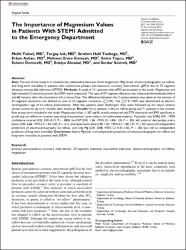The importance of magnesium values in patients with stemi admitted to the emergency department

Göster/
Erişim
info:eu-repo/semantics/openAccessTarih
2017Yazar
Yüksel, MelihIşık, Turgay
Tanboğa, İbrahim Halil
Ayhan, Erkan
Erimşah, Mehmet Emre
Topçu, Selim
Demirelli, Selami
Aksakal, Enbiya
Üst veri
Tüm öğe kaydını gösterÖzet
Aim: The aim of this study is to examine the relationship between initial magnesium (Mg) levels, electrocardiographic no-reflow, and long-term mortality in patients who underwent primary percutaneous coronary intervention (pPCI) due to ST-segment elevation myocardial infarction (STEMI). Methods: A total of 111 patients with pPCI participated in the study. Magnesium and high-sensitive C-reactive protein (hs-CRP) were measured. The sum of ST-segment elevation was measured immediately before and 60 minutes after the restoration of coronary flow. The difference between the 2 measurements was taken as the amount of ST-segment resolution and defined as sum of ST-segment resolution (Sigma STR). The Sigma STR <50% was determined as electrocardiographic sign of no-reflow phenomenon. After the patients were discharged, they were followed up for major adverse cardiac events for up to 51 months after discharge. Results: Forty patients in the no-reflow group and 71 patients in the normal-flow group were included in the study. Magnesium value <= 1.87 mg/dL initially measured had 77% sensitivity and 59% specificity in predicting no-reflow on receiver operating characteristic curve analysis. In multivariate analyses, Mg (odds ratio [OR]: 0.01, <95% confidence interval [CI]: 0.01-0.12; P = .004), hs-CRP (OR: 1.06, <95% CI: 1.00-1.14; P = .05), left anterior descending artery lesion (OR: 6.66, <95% CI: 1.45-3.05; P = .01), and reperfusion time (OR: 1.01, <95% CI: 1.00-1.01; P = .03) were still independent predictors of electrocardiographic no-reflow, and only Mg (OR: 0.08, <95% CI: 0.01-1.03; P = .05) was still an independent predictor of long-term mortality. Conclusion: Serum Mg level is an independent predictor of electrocardiographic no-reflow and long-term mortality in patients with STEMI.

















